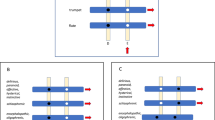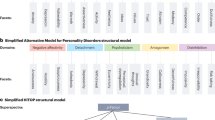Abstract
Between 1896, when Kraepelin published his first formulation of dementia praecox (DP), and 1917, when the American Medico-Psychological Association issued the first official American psychiatric nosology that contained DP and manic-depressive insanity (MDI)—Kraepelin’s key categories—psychiatric nosology in the United States underwent a transformation. I describe and contextualize historically this process using Thomas Clouston, a Scottish Psychiatrist and widely-read textbook author, as a representative pre-Kraepelinian diagnostician. Clouston used three major diagnostic categories based on symptomatic presentation—mania, melancholia and paranoia—all derived from the beginnings of modern psychiatry in the early nineteenth century. He observed that these categories contained good-outcome cases and those progressing to ‘secondary dementia’. Kraepelin designed his categories of DP and MDI to reflect putative distinct disease processes reflected in their course and outcome. Although Clouston and Kraepelin each saw similar patients, their nosologies started from different first principles: symptomatic presentation versus presumed etiology. Driven largely by social forces with American psychiatry, Kraepelin’s system spread throughout the United States in the succeeding decades replacing older diagnostic approaches typified by Clouston’s. In 1896, American psychiatry was demoralized as the idyllic asylums had become overcrowded, isolated scientific backwaters. Kraepelin’s nosology was derived from and was championed by individuals working in high-status research-based university psychiatric clinics. It brought excitement, the promise of subsequent research breakthroughs and the high prestige then associated with German biomedicine. Scientific research comparing the older and Kraepelinian diagnostic systems played little role in this transition. Using empirical methods to guide changes in our diagnostic system is a recent development in the history of psychiatry.
This is a preview of subscription content, access via your institution
Access options
Subscribe to this journal
Receive 12 print issues and online access
$259.00 per year
only $21.58 per issue
Buy this article
- Purchase on Springer Link
- Instant access to full article PDF
Prices may be subject to local taxes which are calculated during checkout

Similar content being viewed by others
References
Noll R . American Madness: The Rise and Fall of Dementia Praecox. Harvard University Press: Cambridge, MA, USA, 2011.
Engstrom EJ . Clinical Psychiatry in Imperial Germany: A History of Psychiatric Practice. Cornell University Press: Ithaca, NY, 2003.
Kraepelin E . Psychiatrie: Ein Lehrbuch für Studirende un Aerzte, 5th (edn). JA Barth: Leipzig, Germany, 1896.
Meyer A . Book Review. Am J Insanity 1896; 53: 298–302.
Beveridge A . Thomas Clouston and the Edinburgh School of Psychiatry. 150 Years of British Psychiatry, 1841–1991. The Royal College of Psychiatrists: London, UK, 1991, pp 359–388.
Fish F . David Skae, M.D., F.R.C.S., Founder of the Edinburgh School of Psychiatry. Med Hist 1965; 9: 36–53.
Clouston TS . Clinical Lectures on Mental Diseases, 1st edn. Henry C Lea's Son & Co. (Dornan): Philadelphia, PA, USA, 1884.
Clouston TS . Clinical Lectures on Mental Diseases, 6th (edn). J & A Churchill: London, UK, 1904.
Clouston TS . Review of clinical lectures on mental diseases. The Journal of Mental Science 1884; 30: 273–279.
Turner TH . A diagnostic analysis of the Casebooks of Ticehurst House Asylum, 1845–1890. Psychol Med Monogr Suppl 1992; 21: 1–70.
Skae D . The Morisonian Lectures on Insanity for 1873: Lecture I (Edited by T.S. Clouston, MD). J Ment Sci 1874; 19: 340–355.
Grob GN . The origins of American psychiatric epidemiology. Am J Public Health 1985; 75: 229–236.
Berrios GE . History of the affective disorders. In: Paykel ES (eds). Handbook of Affective Disorders. Churchill Livingstone: London, UK, 1982, pp 43–56.
Berrios GE . The psychopathology of affectivity: conceptual and historical aspects. Psychol Med 1985; 15: 745–758.
Robertson GM . Does mania include two distinct varieties of insanity, and should it be sub-divided? Br J Psychiatry 1890; 36: 338–347.
Bleuler E . Textbook of Psychiatry by Eugen Bleuler translated by AA Brill. Macmillan & Company: New York, NY, 1924.
Dowbiggin I . Delusional disorder: social section. In: Berrios G, Porter R (eds). A History of Clinical Psychiatry: The Origin and History of Psychiatric Disorders. Athlone: London, UK, 1995 pp 372–284.
Goldstein J . Console and Classify: The French Psychiatric Profession in the Nineteenth Century. Cambridge University Press: New York, NY, USA, 1987.
Kendler KS . Delusional disorder: clinical section. In: Berrios GE, Porter RS (eds). The History of Clinical Psychiatry. Athlone Press: London, UK, 1995 pp 360–371.
Krafft-Ebing Rv . Text-Book of Insanity: Based on Clinical Observations (for Practitioners and Students of Medicine); Translator: Charles Gilbert Chaddock, MD. Davis Company: Philadelphia, PA, USA, 1903.
Kahlbaum KL, Berrios GE . Die Gruppirung der psychischen Krankheiten... Part III (The classification of mental disorders.. Part III). Translated and with an introduction by G. E. Berrios (Classic Text No.25). Hist Psychiatry 1996; 7: 167–181.
Kraam A . On the origin of the clinical standpoint in psychiatry, Dr Ewald Hecker in Gorlitz. Hist Psychiatry 2004; 15 (Part 3): 345–360.
Farrar CB . Dementia praecox in France with some references to the frequency of this diagnosis in America. Am J Insanity 1905; 62: 257–282.
Kraepelin E . Lebenserinnerungen. Springer: Berlin, Germany, 1983.
Berrios GE, Hauser R . The early development of Kraepelin's ideas on classification: a conceptual history. Psychol Med 1988; 18: 813–821.
Kraepelin E . Psychiatrie: Ein Lehrbuch fur Studierende und Aerzte, 6th edn, 2 vols. von Barth Verlag: Leipzig, Germany, 1899.
Norman C . Dementia praecox. BMJ 1904; 1904: 972–976.
Solomon M . Social Empiricism. Bradford Book; The MIT Press: : Cambridge, MA, USA, 2001.
Porter R . The Greatest Benefit to Mankind: A Medical History of Humanity (The Norton History of Science), 1st (edn). WW Norton & Company: New York, NY, USA, 1999.
Carter KC . The Rise of Causal Concepts of Disease: Case Histories. Ashgate Publishing Company: Burlington, VT, USA, 2003.
Grob GN . Mental Illness and American Society 1875–1940. Princeton University Press: Princeton, NJ, USA, 1983.
Kraepelin E . Psychiatry: A Textbook for Students and Physicians (Translation of the 6th Edition of Psychiatrie-Translator Volume 1-Helga Metoui). Translator Volume 1-Helga Metoui; Translation of the 6th Edition of Psychiatrie ed. Science History Publications: Canton, MA, USA, 1990.
Murray GR . Note on the treatment of myxoedema by hypodermic injections of an extract of the thyroid gland of a sheep. BMJ 1891; 2: 796–797.
Kraepelin E . Psychiatry, A Textbook for Students and Physicians (Translation of the 6th Edition of Psychiatrie-Translator Volume 2-Sabine Ayed). Translator Volume 2-Sabine Ayed, Translation of the 6th Edition of Psychiatrie ed. Science History Publications: Canton, MA, USA, 1990.
Noll R . Kraepelin's 'lost biological psychiatry'? Autointoxication, organotherapy and surgery for dementia praecox. Hist Psychiatry 2007; 18 (Part 3): 301–320.
Hill GH . Dementia praecox. Proceedings of the American Medico-Psychological Association at the Fifty-Sixth Annual Meeting Held in Richmond, Virginia; 22–25 May 1900. American Medico-Psychological Association, 1900, pp 282–290.
White WA . The Autobiography of a Purpose. Doubleday, Doran: Garden City, NY, USA, 1938.
Mitchell SW . Address before the Fiftieth Annual Meeting of the American Medico-Psychological Association, held in Philadelphia, May 16th, 1894. J Nerv Ment Dis 1894; 21: 413–437.
Quétel C . History of Syphilis (Translated by Judith Braddock and Brian Pike). The Johns Hopkins University Press: Baltimore, MD, USA, 1990.
Hare EH . The origin and spread of dementia paralytica. J Ment Sci 1959; 105: 594–626.
Noguchi H, Moore JW . A demonstration of Treponema pallidum in the brain in cases of general paralysis. J Expl Med 1913; 17: 232–239.
Lamb SD . Pathologist of the Mind: Adolf Meyer and the Origins of American Psychiatry, 1st (edn). Johns Hopkins University Press: Baltimore, MD, USA, 2014.
Martin SA . Between Kraepelin and Freud: the integrative psychiatry of August Hoch. Hist Psychiatry 2007; 18 (71 Pt 3): 275–299.
Kraepelin E . Clinical Psychiatry: A Text-Book for Students and Physicians. (Abstracted and adapted from the sixth German edition of Kraepelin's ‘Lehrbuch der Psychiatrie’ by A. Ross Diefendorf, MD). The Macmillan Company: New York, NY, USA, 1904.
The Committee on Statistics of the American Medico-Psychological Association. The Classification of Mental Diseases. Am J Insanity 1917; 256–258.
Stevens JR . Neuropathology of schizophrenia. Arch Gen Psychiatry 1982; 39: 1131–1139.
Alzheimer A . Beiträge zur pathologischen Anatomie der Hirnrinde und zur anatomischen Grundlage einiger Psychosen. Monatsschr Psychiatr Neurol 1897; 2: 82–119.
Kendler KS, Zerbin-Rudin E . Abstract and review of ‘Studien Uber Vererbung und Entstehung Geistiger Storungen. I. Zur Vererbung und Neuentstehung der Dementia praecox.’ (Studies on the inheritance and origin of mental illness: I. To the problem of the inheritance and primary origin of dementia praecox). 1916. Am J Med Genet 1996; 67: 338–342.
Kendler KS . An historical framework for psychiatric nosology. Psychol Med 2009; 39: 1935–1941.
Robins E, Guze SB . Establishment of diagnostic validity in psychiatric illness: its application to schizophrenia. Am J Psychiatry 1970; 126: 983–987.
Kendler KS . A history of the DSM-5 Scientific Review Committee. Psychol Med 2013; 43: 1793–1800.
Hull DL . Science as a Process: An Evolutionary Account of the Social and Conceptual Development of Science (Science and its Conceptual Foundations series), reprint edition 15 May 1990. University of Chicago Press: Chicago IL, USA, 1990.
Zachar P, Kendler KS . The removal of Pluto from the class of planets and homosexuality from the class of psychiatric disorders: A comparison. Philos Ethics Humanit Med 2012; 7: 4.
Solomon M . Making Medical Knowledge, 1st (edn). Oxford University Press: New York, NY, USA, 2015.
Acknowledgements
Noll’s recent book (ref. 1) was important in pointing me toward relevant primary sources.
Author information
Authors and Affiliations
Corresponding author
Ethics declarations
Competing interests
The author declares no conflict of interest.
Additional information
Supplementary Information accompanies the paper on the Molecular Psychiatry website
Supplementary information
PowerPoint slides
Rights and permissions
About this article
Cite this article
Kendler, K. The transformation of American psychiatric nosology at the dawn of the twentieth century. Mol Psychiatry 21, 152–158 (2016). https://doi.org/10.1038/mp.2015.188
Received:
Revised:
Accepted:
Published:
Issue Date:
DOI: https://doi.org/10.1038/mp.2015.188
This article is cited by
-
Long-term effects of the COVID-19 pandemic on five mental and psychological disorders: in terms of the number of disease visits, drug consumption, and scale scores
BMC Psychiatry (2023)
-
The development of Kraepelin’s mature diagnostic concept of hebephrenia: a close reading of relevant texts of Hecker, Daraszkiewicz, and Kraepelin
Molecular Psychiatry (2020)
-
On the diagnostic and neurobiological origins of bipolar disorder
Translational Psychiatry (2020)
-
Reconsidering the prognosis of major depressive disorder across diagnostic boundaries: full recovery is the exception rather than the rule
BMC Medicine (2017)
-
David Skae and his nineteenth century etiologic psychiatric diagnostic system: looking forward by looking back
Molecular Psychiatry (2017)



